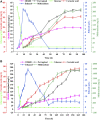Metabolic Engineering of Saccharomyces cerevisiae for Heterologous Carnosic Acid Production
- PMID: 35721856
- PMCID: PMC9201568
- DOI: 10.3389/fbioe.2022.916605
Metabolic Engineering of Saccharomyces cerevisiae for Heterologous Carnosic Acid Production
Abstract
Carnosic acid (CA), a phenolic tricyclic diterpene, has many biological effects, including anti-inflammatory, anticancer, antiobesity, and antidiabetic activities. In this study, an efficient biosynthetic pathway was constructed to produce CA in Saccharomyces cerevisiae. First, the CA precursor miltiradiene was synthesized, after which the CA production strain was constructed by integrating the genes encoding cytochrome P450 enzymes (P450s) and cytochrome P450 reductase (CPR) SmCPR. The CA titer was further increased by the coexpression of CYP76AH1 and SmCPR ∼t28SpCytb5 fusion proteins and the overexpression of different catalases to detoxify the hydrogen peroxide (H2O2). Finally, engineering of the endoplasmic reticulum and cofactor supply increased the CA titer to 24.65 mg/L in shake flasks and 75.18 mg/L in 5 L fed-batch fermentation. This study demonstrates that the ability of engineered yeast cells to synthesize CA can be improved through metabolic engineering and synthetic biology strategies, providing a theoretical basis for microbial synthesis of other diterpenoids.
Keywords: Saccharomyces cerevisiae; carnosic acid; miltiradiene; synthetic biology; terpenoid.
Copyright © 2022 Wei, Zhang, Bian and Lu.
Conflict of interest statement
The authors declare that the research was conducted in the absence of any commercial or financial relationships that could be construed as a potential conflict of interest.
Figures







Similar articles
-
[Construction of Saccharomyces cerevisiae cell factory for efficient biosynthesis of ferruginol].Zhongguo Zhong Yao Za Zhi. 2025 Feb;50(4):1031-1042. doi: 10.19540/j.cnki.cjcmm.20241115.104. Zhongguo Zhong Yao Za Zhi. 2025. PMID: 40350820 Chinese.
-
Construction and optimization of Saccharomyces cerevisiae for synthesizing forskolin.Appl Microbiol Biotechnol. 2022 Mar;106(5-6):1933-1944. doi: 10.1007/s00253-022-11819-z. Epub 2022 Mar 2. Appl Microbiol Biotechnol. 2022. PMID: 35235006
-
Engineering chimeric diterpene synthases and isoprenoid biosynthetic pathways enables high-level production of miltiradiene in yeast.Metab Eng. 2020 Jul;60:87-96. doi: 10.1016/j.ymben.2020.03.011. Epub 2020 Apr 5. Metab Eng. 2020. PMID: 32268192
-
Multiplexed engineering of cytochrome P450 enzymes for promoting terpenoid synthesis in Saccharomyces cerevisiae cell factories: A review.Biotechnol Adv. 2025 Jul-Aug;81:108560. doi: 10.1016/j.biotechadv.2025.108560. Epub 2025 Mar 9. Biotechnol Adv. 2025. PMID: 40068711 Review.
-
Engineering Saccharomyces cerevisiae to produce plant benzylisoquinoline alkaloids.aBIOTECH. 2021;2(3):264-275. doi: 10.1007/s42994-021-00055-0. Epub 2021 Jul 18. aBIOTECH. 2021. PMID: 34377581 Free PMC article. Review.
Cited by
-
Advances in the Structures, Pharmacological Activities, and Biosynthesis of Plant Diterpenoids.J Microbiol Biotechnol. 2024 Aug 28;34(8):1563-1579. doi: 10.4014/jmb.2402.02014. Epub 2024 Jun 17. J Microbiol Biotechnol. 2024. PMID: 39081244 Free PMC article. Review.
-
Biosynthesis of Edible Terpenoids: Hosts and Applications.Foods. 2025 Feb 17;14(4):673. doi: 10.3390/foods14040673. Foods. 2025. PMID: 40002116 Free PMC article. Review.
-
Two-Phase Fermentation Systems for Microbial Production of Plant-Derived Terpenes.Molecules. 2024 Mar 2;29(5):1127. doi: 10.3390/molecules29051127. Molecules. 2024. PMID: 38474639 Free PMC article. Review.
-
Combinatorial metabolic engineering of Yarrowia lipolytica for high-level production of the plant-derived diterpenoid sclareol.Microb Cell Fact. 2025 May 16;24(1):110. doi: 10.1186/s12934-025-02744-7. Microb Cell Fact. 2025. PMID: 40380140 Free PMC article.
-
Biotransformation of Phenolic Acids in Foods: Pathways, Key Enzymes, and Technological Applications.Foods. 2025 Jun 23;14(13):2187. doi: 10.3390/foods14132187. Foods. 2025. PMID: 40646939 Free PMC article. Review.
References
-
- Brückner K., Božić D., Manzano D., Papaefthimiou D., Pateraki I., Scheler U., et al. (2014). Characterization of Two Genes for the Biosynthesis of Abietane-type Diterpenes in Rosemary (Rosmarinus Officinalis) Glandular Trichomes. Phytochemistry 101, 52–64. 10.1016/j.phytochem.2014.01.021 - DOI - PubMed
LinkOut - more resources
Full Text Sources
Molecular Biology Databases

